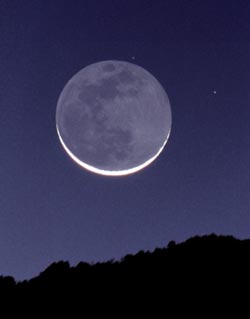
The lower edge of this very young crescent Moon is bright with direct sunlight, but the shadowed part of the disk is also visible thanks to 'earthshine' — reflected sunlight from Earth.
Courtesy Matt BenDaniel.
Perhaps you've noticed at times that the "dark" part of a crescent Moon isn't completely dark. Sunlight reflected by Earth casts an eerie glow on the shaded lunar disk, in a phenomenon known as earthshine. The cloudier it gets, the more light Earth reflects onto the Moon, so measuring earthshine is a good way to track cloud cover. And by monitoring earthshine over a period of several years, astronomers have discovered what might be an important factor for predicting climate change.
Since 1999, Enric Pallé (Big Bear Solar Observatory, California) and his colleagues have measured the intensity of earthshine and hence, the percentage of sunlight that Earth reflects. By combining ground-based lunar observations with archived satellite data on clouds, they have calculated Earth's "reflectance" all the way back to 1985. The earthshine results show a long-term dip in cloud cover of about 6.5 percent between 1985 and 1997, then a roughly equal increase between 1997 and 2003.
The observed decrease might have significantly warmed the Earth by letting more sunlight in. "The changes through the 1980s and 1990s are a little more than twice what's attributed to global warming," says Philip R. Goode (New Jersey Institute of Technology), one of Pallé's collaborators. But Goode is careful to point out that the changes observed could simply be part of a natural cycle that averages out over time, in which case there would be no lasting impact.
Another complicating factor, says climate modeler Richard T. Wetherald (National Oceanic and Atmospheric Administration), is that clouds don't just block solar radiation — they also help retain heat by trapping infrared radiation emitted from Earth's surface. "Changes in cloud cover can warm, cool, or keep things the same," depending on their altitude, he says. High-altitude clouds are better at trapping the Earth's heat, and don't reflect sunlight as well, so they tend to give a net heating effect. Low clouds have an overall cooling effect, and mid-range clouds are more or less neutral.
"If real, [cloud cover variability] is a phenomenon that has heretofore been unincorporated into our understanding of climate variability," says Ellsworth G. Dutton (National Oceanic and Atmospheric Administration), who heads the Solar and Thermal Atmospheric Radiation project.
Goode thinks the variability is due to natural causes rather than human influences, but he is as puzzled as anyone else about what the specific mechanism might be. "Either way, we need to make more observations," he says. The group is now trying to organize a network of earthshine observatories that will provide backup when weather conditions prevent observations from a single given site. The group would also like to acquire data over the entire 11-year solar cycle, which is known to affect Earth's climate.
 0
0
Comments
You must be logged in to post a comment.